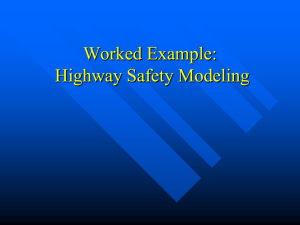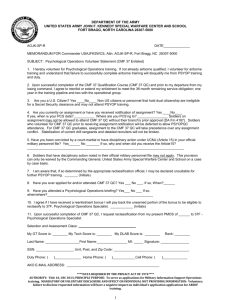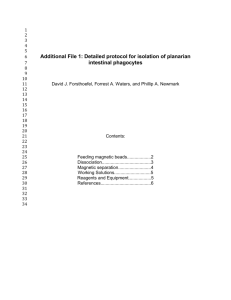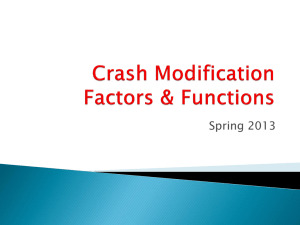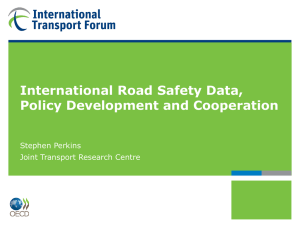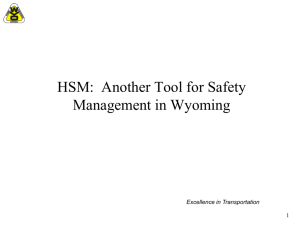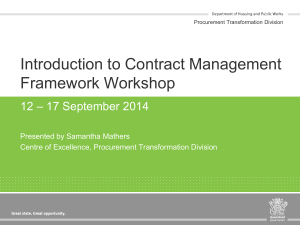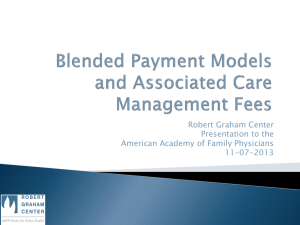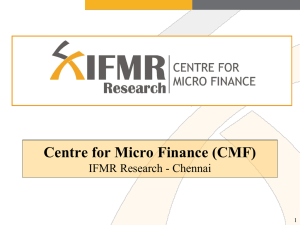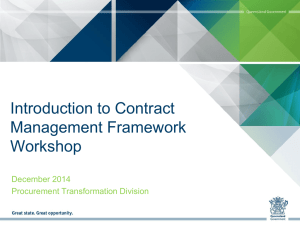CMF - 2015 Traffic Records Forum
advertisement
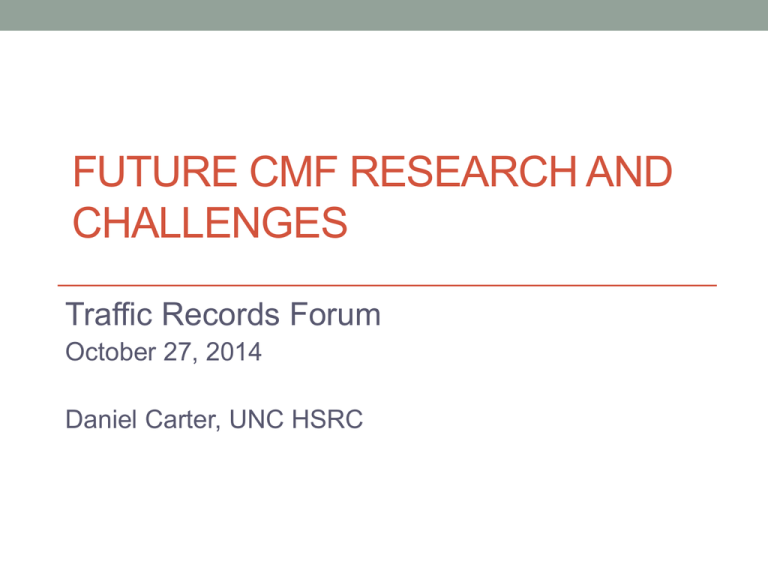
FUTURE CMF RESEARCH AND CHALLENGES Traffic Records Forum October 27, 2014 Daniel Carter, UNC HSRC Motivation How do site characteristics and countermeasures affect road safety? CMF How do site characteristics and countermeasures affect a CMF? The question at hand Research Project • NCHRP 17-63 – Guidance on the Development and Application of Crash Modification Factors • UNC Highway Safety Research Center • Vanesse Hangin Brustlin, Inc. • Persaud and Lyon, Inc. • Kittleson and Associates, Inc. • Structured by three main objectives OBJECTIVE 1. TRANSFERABILITY Develop guidelines for calibration of current CMFs to assess treatment effectiveness at sites for which key site characteristics may be different. Transferability Rural Kansas Rural Washington Rural Maine Rural Connecticut Questions • When a countermeasure is applied to a different type of • • • • site, will it be MORE effective? Or LESS? Or EQUAL? When will this be the case? What site characteristics will impact the CMF value? Using Existing Data • Information from the CMF Clearinghouse • Treatments with many studies • Cumulative meta-analysis • CMFunctions • Detailed disaggregate data analysis • Information on individual locations • Location-specific characteristics Exploration of Influential Factors Treatment Influential Factors on the CMF Area and Facility Type Study Citation Installation of safety edge treatment Paved vs unpaved shoulder types Rural 2 lane roads Signal to roundabout conversion Number of lanes (1 vs. 2), area type (urban vs. suburban), number of intersection legs (3 vs. 4) Signalized intersections in urban and suburban areas Graham, J.L., Richard, K.R. , O'Laughlin, M.K., Harwood, D.W., "Safety Evaluation of the Safety Edge Treatment" Report No. FHWA-HRT-11-024, Federal Highway Administration, Washington, DC. (2011) Srinivasan, R., Baek, J., Smith, S., Sundstrom, C., Carter, D., Lyon, C., Persaud, B., Gross, F., Eccles, K., Hamidi, A., and Lefler, N., "NCHRP Report 705: Evaluation of Safety Strategies at Signalized Intersections.", Washington, D.C., Transportation Research Board, National Research Council, (2011) Guidance to Produce • Guidance on overall procedure for selecting and applying a CMF • Guidance on identifying influential factors for a CMF • Preset list of influential factors for common safety treatments and treatment categories • Guidance for identifying influential factors if CMF is not in the preset list • Guidance on testing CMFs for homogeneity • Guidance on adjusting CMFs for differences in site conditions • Physical characteristics • Volume distribution • Crash type and severity OBJECTIVE 2. MULTIPLE COUNTERMEASURES Develop guidelines for how existing and future CMFs can be combined in a single location with multiple treatments. Multiple Countermeasures Questions • Will multiple countermeasures have an effect that’s GREATER than the individual countermeasures? • Or LESS? • Or EQUAL? • And when will this be true? Identified Existing Methods for Combining CMFs • Multiplicative Methods • Dominant Effect Method • Dominant Effect by Crash Type • Dominant Common Residuals Method • Estimating Combined Effect for Unknown Interaction Define Ground Truth Treatment Q Level 1 (Not Present) 2 (Present) A (Not Present) A1 A2 B (Present) B1 B2 Treatment P Assess and Validate Methods • Assess validity of identified methods (compare results of methods to ground truth) • Identify most possible scenarios of interaction effects • Select best method (or develop a new one) and validate against real world dataset Guidance to Produce • Guidance on combining single CMFs to estimate combined effects • Step-by-step procedures and examples for selecting and applying appropriate method(s) Example of Guidance to Produce Define Applicability of Individual CMFs (i.e., to what crash types and severities do the individual CMFs apply?) Same Crash Type and Severity Different Crash Type and Severity Define Categories for Individual Treatments (e.g., roadway, roadside, intersection) Define Categories for Individual Treatments (e.g., roadway, roadside, intersection) Same General Category Different General Category Same General Category Different General Category Large Potential Interaction Effect: Apply Method 1 Medium Potential Interaction Effect: Apply Method 2 Small Potential Interaction Effect: Apply Method 3 Negligible Potential Interaction Effect: Apply Method 4 OBJECTIVE 3. CRASH MODIFICATION FUNCTION DEVELOPMENT Develop recommended procedures for formulating and calibrating future CMFs that identify key influential site characteristics. CMFunction Development Questions • How can CMFunctions be developed from regression model coefficients? • Key is to explore interactive effects between the CMF and non- CMF related variables (e.g., interaction between centerline rumble strips and AADT). • How can CMFunctions be developed from CMF point estimates? • CMF point estimates from the same study with a variety of application circumstances. • CMF point estimates from different studies • Combination of the first two scenarios Guidance to Produce • Guidance for developing CMFunctions and assessing fit • Guidance for quantifying the CMF standard error when computed as a function. • Guidance on planning and designing studies (e.g., experimental) and treatments to better facilitate the development of CMFunctions Potential Data Sources • Two-way to multi-way stop control (NC) • Improved curve delineation (CT, WA) • Stop to signal control conversion (NC, CA) • Improving pavement friction (MN, PA) Thank You Daniel Carter UNC Highway Safety Research Center daniel_carter@unc.edu
